Lamborghini
From Wikipedia, the free encyclopedia
This article is about the car brand. For the KSI song, see Lamborghini (song). For the 1997 video game, see Automobili Lamborghini. For the cancelled video game, see Lamborghini (video game). For other uses, see Lamborghini (disambiguation).
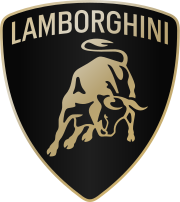 |
|
| Private[1] | |
| Industry |
|
| Fate | Acquired by Audi (September 1998)[2] |
| Founded |
|
| Founder | Ferruccio Lamborghini |
| Headquarters | Sant'Agata Bolognese, Italy[1] |
|
Area served
|
Worldwide |
|
Key people
|
|
| Products |
|
|
Production output
|
|
| Revenue |
|
| Profit |
|
| Total equity |
|
|
Number of employees
|
|
| Parent | Audi[10][12] |
| Subsidiaries |
|
| Website | lamborghini |
Ferruccio Lamborghini, an Italian manufacturing magnate, founded Automobili Ferruccio Lamborghini S.p.A. in 1963 to compete with established marques, including Ferrari. The company gained wide acclaim in 1966 for the Miura sports coupé, which established rear mid-engine, rear wheel drive as the standard layout for high-performance cars of the era. Lamborghini grew rapidly during its first decade, but sales plunged in the wake of the 1973 worldwide financial downturn and the oil crisis. The firm's ownership changed three times after 1973, including a bankruptcy in 1978. American Chrysler Corporation took control of Lamborghini in 1987 and sold it to Malaysian investment group Mycom Setdco and Indonesian group V'Power Corporation in 1994. In 1998, Mycom Setdco and V'Power sold Lamborghini to the Volkswagen Group where it was placed under the control of the group's Audi division.
New products and model lines were introduced to the brand's portfolio and brought to the market and saw an increased productivity for the brand Lamborghini. In the late 2000s, during the worldwide financial crisis and the subsequent economic crisis, Lamborghini's sales saw a drop of nearly 50 percent.
Lamborghini produces sports cars and V12 engines for offshore powerboat racing. Lamborghini currently produces the V12-powered Aventador and the V10-powered Huracán.
Contents
History
Main article: History of Lamborghini
Manufacturing magnate Italian Ferruccio Lamborghini founded the company in 1963 with the objective of producing a refined grand touring car to compete with offerings from established marques such as Ferrari.
The company's first models were released in the mid-1960s and were
noted for their refinement, power and comfort. Lamborghini gained wide
acclaim in 1966 for the Miura sports coupé, which established rear mid-engine, rear wheel drive as the standard layout for high-performance cars of the era.Lamborghini grew rapidly during its first ten years, but sales plunged in the wake of the 1973 worldwide financial downturn and the oil crisis. Ferruccio Lamborghini sold ownership of the company to Georges-Henri Rossetti and René Leimer and retired in 1974. The company went bankrupt in 1978, and was placed in the receivership of brothers Jean-Claude and Patrick Mimran in 1980. The Mimrans purchased the company out of receivership by 1984 and invested heavily in the company's expansion. Under the Mimrans' management, Lamborghini's model line was expanded from the Countach to include the Jalpa sports car and the LM002 high performance off-road vehicle.
The Mimrans sold Lamborghini to the Chrysler Corporation in 1987. After replacing the Countach with the Diablo and discontinuing the Jalpa and the LM002, Chrysler sold Lamborghini to Malaysian investment group Mycom Setdco and Indonesian group V'Power Corporation in 1994. In 1998, Mycom Setdco and V'Power sold Lamborghini to the Volkswagen Group where it was placed under the control of the group's Audi division. New products and model lines were introduced to the brand's portfolio and brought to the market and saw an increased productivity for the brand Lamborghini. In the late 2000s, during the worldwide financial crisis and the subsequent economic crisis, Lamborghini's sales saw a drop of nearly 50 percent.
Products
Automobiles
Main article: List of Lamborghini automobiles
As of the 2015 model year, Lamborghini's automobile product range
consists of two model lines, both of which are mid-engine two-seat
sports cars.[14] The V12-powered Aventador line consists of the LP 700–4 coupé and roadster.[15] The V10-powered Huracán line currently includes only the LP 610-4 coupé.[citation needed]Marine engines
Motori Marini Lamborghini produces a large V12 marine engine block for use in World Offshore Series Class 1 powerboats. A Lamborghini branded marine engine displaces approximately 8,171 cc (499 cu in) and outputs approximately 940 hp (700 kW).[16]Lamborghini motorcycle
In the mid-1980s, Lamborghini produced a limited-production run of a 1,000 cc sports motorcycle. UK weekly newspaper Motor Cycle News reported in 1994 – when featuring an example available through an Essex motorcycle retailer - that 24 examples were produced with a Lamborghini alloy frame having adjustable steering head angle, Kawasaki GPz1000RX engine/transmission unit, Ceriani front forks and Marvic wheels. The bodywork was plastic and fully integrated with front fairing merged into fuel tank and seat cover ending in a rear tail-fairing. The motorcycles were designed by Lamborghini stylists and produced by French business Boxer Bikes.[17]Branded merchandise
Lamborghini licenses its brand to manufacturers that produce a variety of Lamborghini-branded consumer goods including scale models, clothing, accessories, bags, electronics[18] and laptop computers.[19]Motorsport
In the mid-1970s, while Lamborghini was under the management of Georges-Henri Rossetti, Lamborghini entered into an agreement with BMW to develop, then manufacture 400 cars for BMW in order to meet Group 4 homologation requirements. BMW lacked experience developing a mid-engined vehicle and believed that Lamborghini's experience in that area would make Lamborghini an ideal choice of partner. Due to Lamborghini's shaky finances, Lamborghini fell behind schedule developing the car's structure and running gear. When Lamborghini failed to deliver working prototypes on time, BMW took the program in house, finishing development without Lamborghini. BMW contracted with Baur to produce the car, which BMW named the M1, delivering the first vehicle in October 1978.[21][22]
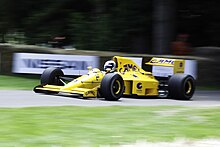
The 1990 Lotus 102 featured a Lamborghini V12.
Lamborghini was an engine supplier in Formula One between the 1989 and 1993 Formula One seasons. It supplied engines to Larrousse (1989–1990,1992–1993), Lotus (1990), Ligier (1991), Minardi (1992), and to the Modena team in 1991. While the latter is commonly referred to as a factory team, the company saw themselves as a supplier, not a backer. The 1992 Larrousse–Lamborghini was largely uncompetitive but noteworthy in its tendency to spew oil from its exhaust system. Cars following closely behind the Larrousse were commonly coloured yellowish-brown by the end of the race.[citation needed] Lamborghini's best result was achieved with Larrousse at the 1990 Japanese Grand Prix, when Aguri Suzuki finished third on home soil.[24]
In late 1991, a Lamborghini Formula One motor was used in the Konrad KM-011 Group C sports car, but the car only lasted a few races before the project was canceled. The same engine, re-badged a Chrysler, Lamborghini's then-parent company, was tested by McLaren towards the end of the 1993 season, with the intent of using it during the 1994 season. Although driver Ayrton Senna was reportedly impressed with the engine's performance, McLaren pulled out of negotiations, choosing a Peugeot engine instead, and Chrysler ended the project.
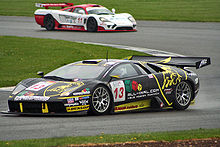
A Murcielago R-GT participating in the FIA GT Championship at Silverstone in 2006.
Complete Formula One results
(key) (results in bold indicate pole position)| Year | Entrant | Chassis | Engine(s) | Tyres | Drivers | 1 | 2 | 3 | 4 | 5 | 6 | 7 | 8 | 9 | 10 | 11 | 12 | 13 | 14 | 15 | 16 | Points | WCC |
|---|---|---|---|---|---|---|---|---|---|---|---|---|---|---|---|---|---|---|---|---|---|---|---|
| 1989 | Larrousse Calmels | Lola LC88B Lola LC89 |
Lamborghini 3512 V12 | G | BRA | SMR | MON | MEX | USA | CAN | FRA | GBR | GER | HUN | BEL | ITA | POR | ESP | JPN | AUS | 1 | 15th | |
| DNQ | Ret | DNQ | DNQ | DNQ | DNQ | ||||||||||||||||||
| 11 | Ret | ||||||||||||||||||||||
| Ret | Ret | Ret | Ret | 11 | DNPQ | DNQ | DNPQ | ||||||||||||||||
| 12 | Ret | Ret | Ret | Ret | Ret | Ret | Ret | Ret | DNPQ | 16 | Ret | 9 | 6 | Ret | Ret | ||||||||
| 1990 | ESPO Larrousse F1 | Lola LC89B Lola LC90 |
Lamborghini 3512 V12 | G | USA | BRA | SMR | MON | CAN | MEX | FRA | GBR | GER | HUN | BEL | ITA | POR | ESP | JPN | AUS | 11 | 6th | |
| 8 | Ret | 13 | 6 | 9 | Ret | 8 | 4 | Ret | 6 | 9 | Ret | Ret | Ret | Ret | Ret | ||||||||
| Ret | Ret | Ret | Ret | 12 | Ret | 7 | 6 | Ret | Ret | Ret | Ret | 14 | 6 | 3 | Ret | ||||||||
| Camel Team Lotus | Lotus 102 | Lamborghini V12 | G | ||||||||||||||||||||
| Ret | Ret | 7 | Ret | 6 | 10 | 11 | Ret | 8 | 5 | 11 | Ret | Ret | Ret | Ret | Ret | 3 | 8th | ||||||
| DNS | Ret | 8 | Ret | Ret | 8 | 12 | Ret | Ret | 7 | 12 | Ret | Ret | DNS | ||||||||||
| Ret | Ret | ||||||||||||||||||||||
| 1991 | Equipe Ligier Gitanes | Ligier JS35 Ligier JS35B |
Lamborghini 3512 V12 |
G | USA | BRA | SMR | MON | CAN | MEX | FRA | GBR | GER | HUN | BEL | ITA | POR | ESP | JPN | AUS | 0 | NC | |
| Ret | Ret | 7 | 7 | Ret | 8 | 12 | Ret | 9 | 17 | 11 | Ret | 16 | Ret | 9 | Ret | ||||||||
| DNQ | Ret | 10 | 10 | 8 | DNQ | 11 | DNQ | Ret | 10 | Ret | 11 | 11 | Ret | Ret | 18 | ||||||||
| Modena Team SpA | Lambo 291 | Lamborghini L3512 V12 | G | 7 | DNPQ | DNPQ | DNPQ | DNPQ | DNPQ | DNPQ | DNPQ | Ret | 16 | DNQ | 16 | DNQ | DNQ | DNQ | Ret | 0 | NC | ||
| DNPQ | DNPQ | 9 | DNPQ | DNPQ | DNPQ | DNPQ | DNPQ | DNQ | DNQ | DNQ | DNQ | DNQ | DNQ | DNQ | DNQ | ||||||||
| 1992 | Central Park Venturi Larrousse | Venturi LC92 | Lamborghini 3512 V12 | G | RSA | MEX | BRA | ESP | SMR | MON | CAN | FRA | GBR | GER | HUN | BEL | ITA | POR | JPN | AUS | 1 | 11th | |
| Ret | 11 | Ret | Ret | Ret | 6 | DSQ | Ret | Ret | 14 | Ret | 18 | Ret | Ret | Ret | Ret | ||||||||
| 12 | 12 | 9 | DNQ | Ret | DNPQ | Ret | Ret | Ret | Ret | Ret | 17 | 9 | Ret | 11 | Ret | ||||||||
| Minardi Team | M191B M191L M192 |
Lamborghini 3512 3.5 V12 | G | Ret | Ret | Ret | 11 | Ret | 8 | 13 | DNQ | DNQ | DNQ | 12 | 6 | 9 | 1 | 12th | |||||
| DNQ | Ret | DNQ | |||||||||||||||||||||
| Ret | Ret | 7 | Ret | Ret | Ret | 11 | 8 | 17 | 12 | DNQ | 16 | Ret | 14 | 14 | 10 | ||||||||
| 1993 | Larrousse F1 | Larrousse LH93 | Lamborghini 3512 V12 | G | RSA | BRA | EUR | SMR | ESP | MON | CAN | FRA | GBR | GER | HUN | BEL | ITA | POR | JPN | AUS | 3 | 10th | |
| Ret | 7 | Ret | 5 | Ret | 12 | Ret | 9 | 11 | 12 | 8 | 12 | 9 | 10 | ||||||||||
| 12 | 14 | ||||||||||||||||||||||
| Ret | 10 | 9 | Ret | 9 | Ret | 8 | 16 | Ret | Ret | Ret | Ret | 6 | 11 | Ret | 12 |
Marketing
Brand identity
The world of bullfighting is a key part of Lamborghini's identity.[31][32][33] In 1962, Ferruccio Lamborghini visited the Seville ranch of Don Eduardo Miura, a renowned breeder of Spanish fighting bulls. Lamborghini, a Taurus himself, was so impressed by the majestic Miura animals that he decided to adopt a raging bull as the emblem for the automaker he would open shortly.[34]Vehicle nomenclature
After producing two cars with alphanumeric designations, Lamborghini once again turned to the bull breeder for inspiration. Don Eduardo was filled with pride when he learned that Ferruccio had named a car for his family and their line of bulls; the fourth Miura to be produced was unveiled to him at his ranch in Seville.[34][35]The automaker would continue to draw upon the bullfighting connection in future years. The Islero was named for the Miura bull that killed the famed bullfighter Manolete in 1947. Espada is the Spanish word for sword, sometimes used to refer to the bullfighter himself. The Jarama's name carried a special double meaning; though it was intended to refer only to the historic bullfighting region in Spain, Ferruccio was concerned about confusion with the also historic Jarama motor racing track.[36]
The Jalpa of 1982 was named for a bull breed; Diablo, for the Duke of Veragua's ferocious bull famous for fighting an epic battle against "El Chicorro" in Madrid in 1869;[39][40][41] Murciélago, the legendary bull whose life was spared by "El Lagartijo" for his performance in 1879; Gallardo, named for one of the five ancestral castes of the Spanish fighting bull breed;[42] and Reventón, the bull that defeated young Mexican torero Félix Guzmán in 1943. The Estoque concept of 2008 was named for the estoc, the sword traditionally used by matadors during bullfights.[43]
Concept vehicles
See also: List of Lamborghini concept vehicles
Throughout its history, Lamborghini has envisioned and presented a variety of concept cars, beginning in 1963 with the very first Lamborghini prototype, the 350GTV. Other famous models include Bertone's 1967 Marzal, 1974 Bravo, and 1980 Athon, Chrysler's 1987 Portofino, the Italdesign-styled Cala from 1995, the Zagato-built Raptor from 1996.A retro-styled Lamborghini Miura concept car, the first creation of chief designer Walter de'Silva, was presented in 2006. President and CEO Stephan Winkelmann denied that the concept would be put into production, saying that the Miura concept was "a celebration of our history, but Lamborghini is about the future. Retro design is not what we are here for. So we won’t do the [new] Miura.”[44]
At the 2008 Paris Motor Show, Lamborghini revealed the Estoque, a four-door sedan concept. Although there had been much speculation regarding the Estoque's eventual production,[45][46] Lamborghini management has not made a decision regarding production of what might be the first four-door car to roll out of the Sant'Agata factory.[47]
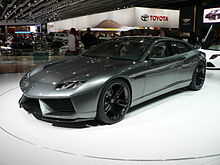
The Estoque, a 2008 sedan concept.
At the 2012 Geneva Motor Show, Lamborghini unveiled the Aventador J – a roofless, windowless version of the Lamborghini Aventador. The Aventador J uses the same 700 hp engine and seven-speed transmission as the standard Aventador.[49]
At the 2012 Beijing Motor Show, Lamborghini unveiled the Urus SUV. This is the first SUV By Lamborghini since the LM002.
As part of the celebration of 50 years of Lamborghini, the company unveiled the Egoista. Egoista is for one person's driving and only one of Egoista is to be made.[50]
At the 2014 Paris Motor Show, Lamborghini unveiled the Asterion LPI910-4 hybrid concept car. Named after the actual half-man, half-bull hybrid (Minotaur) of Greek legend, it is the first hybrid Lamborghini in the history of the company ("Asterion" was the traditional proper name of another hybrid – namely, . Utilizing the Huracán's 5.2 litre V10 producing 607 horsepower, along with one electric motor mounted on the transaxle and an additional two on the front axle, developing an additional 300 horsepower. This puts the power at a combined figure of 907 horsepower. 0–100 km/h is claimed to be "just above 3 seconds," with a claimed top speed of 185 mph.[51]
Corporate affairs
Structure
As of 2011, Lamborghini is structured as a wholly owned subsidiary of AUDI AG named Automobili Lamborghini S.p.A.[Notes 1][10]Automobili Lamborghini S.p.A. controls five principal subsidiaries: Ducati Motor Holding S.p.A., a manufacturer of motorcycles; Italdesign Giugiaro S.p.A., a 90.1%-owned design and prototyping firm that provides services to the entire Volkswagen Group; MML S.p.A. (Motori Marini Lamborghini), a manufacturer of marine engine blocks; and VOLKSWAGEN GROUP ITALIA S.p.A. (formerly AUTOGERMA S.p.A.), which sells Audi and other Volkswagen Group vehicles in Italy.[10][13]
Sales results
By sales, the most important markets in 2004 for Lamborghini's sports cars are the U.S. (41%), Germany (13%), Great Britain (9%) and Japan (8%). Prior to the launch of the Gallardo in 2003, Lamborghini produced approximately 400 vehicles per year; in 2011 Lamborghini produced 1,711 vehicles.[52]| This section requires expansion. (April 2009) |
| Year | Units sold | ||||||||||||||||||||||||||||||||||||||||||||||||||
|---|---|---|---|---|---|---|---|---|---|---|---|---|---|---|---|---|---|---|---|---|---|---|---|---|---|---|---|---|---|---|---|---|---|---|---|---|---|---|---|---|---|---|---|---|---|---|---|---|---|---|---|
| 500 | 1,000 | 1,500 | 2,000 | 2,500 | |||||||||||||||||||||||||||||||||||||||||||||||
| Ferruccio Lamborghini (1963–1972) | |||||||||||||||||||||||||||||||||||||||||||||||||||
| 1968[53] | 353 | ||||||||||||||||||||||||||||||||||||||||||||||||||
| Georges-Henri Rossetti and René Leimer (1972–1977) | |||||||||||||||||||||||||||||||||||||||||||||||||||
| Receivership (1977–1984) | |||||||||||||||||||||||||||||||||||||||||||||||||||
| Patrick Mimran (1984–1987) | |||||||||||||||||||||||||||||||||||||||||||||||||||
| Chrysler Corporation (1987–1994) | |||||||||||||||||||||||||||||||||||||||||||||||||||
| 1991[54] | 673 | ||||||||||||||||||||||||||||||||||||||||||||||||||
| 1992[54] | 166 | ||||||||||||||||||||||||||||||||||||||||||||||||||
| 1993[54] | 215 | ||||||||||||||||||||||||||||||||||||||||||||||||||
| MegaTech (1994–1995) | |||||||||||||||||||||||||||||||||||||||||||||||||||
| V'Power and Mycom Sedtco (1995–1998) | |||||||||||||||||||||||||||||||||||||||||||||||||||
| 1996[55] | 211 | ||||||||||||||||||||||||||||||||||||||||||||||||||
| 1997[54] | 209 | ||||||||||||||||||||||||||||||||||||||||||||||||||
| AUDI AG (1999–) | |||||||||||||||||||||||||||||||||||||||||||||||||||
| 1999[56] | 265 | ||||||||||||||||||||||||||||||||||||||||||||||||||
| 2000[57] | 296 | ||||||||||||||||||||||||||||||||||||||||||||||||||
| 2001[58] | 297 | ||||||||||||||||||||||||||||||||||||||||||||||||||
| 2002[59] | 424 | ||||||||||||||||||||||||||||||||||||||||||||||||||
| 2003[60] | 1,305 | ||||||||||||||||||||||||||||||||||||||||||||||||||
| 2004[60] | 1,592 | ||||||||||||||||||||||||||||||||||||||||||||||||||
| 2005[61] | 1,600 | ||||||||||||||||||||||||||||||||||||||||||||||||||
| 2006[62] | 2,087 | ||||||||||||||||||||||||||||||||||||||||||||||||||
| 2007[63] | 2,406 | ||||||||||||||||||||||||||||||||||||||||||||||||||
| 2008[64] | 2,430 | ||||||||||||||||||||||||||||||||||||||||||||||||||
| 2009[65] | 1,515 | ||||||||||||||||||||||||||||||||||||||||||||||||||
| 2010[66] | 1,302 | ||||||||||||||||||||||||||||||||||||||||||||||||||
| 2011[67] | 1,602 | ||||||||||||||||||||||||||||||||||||||||||||||||||
| 2012[68] | 2,083 | ||||||||||||||||||||||||||||||||||||||||||||||||||
| 2013[69] | 2,121 | ||||||||||||||||||||||||||||||||||||||||||||||||||
| 2014[70] | 2,530 | ||||||||||||||||||||||||||||||||||||||||||||||||||
Licensing
Automóviles Lamborghini Latinoamérica
Automóviles Lamborghini Latinoamérica S.A. de C.V. (Lamborghini Automobiles of Latin America Public Limited Company) is an authorized distributor and manufacturer of Lamborghini-branded vehicles and merchandise in Latin America and South America.[71]In 1995, Indonesian corporation MegaTech, Lamborghini's owner at the time, entered into distribution and license agreements with Mexican businessman Jorge Antonio Fernandez Garcia. The agreements give Automóviles Lamborghini Latinoamérica S.A. de C.V. the exclusive distributorship of Lamborghini vehicles and branded merchandise in Latin America and South America. Under the agreements, Automóviles Lamborghini is also allowed to manufacture Lamborghini vehicles and market them worldwide under the Lamborghini brand.[71]
Automóviles Lamborghini has produced two rebodied versions of the Diablo called the Eros and the Coatl. In 2015, Automóviles Lamborghini transferred the IP-rights to the Coatl foundation (chamber of commerce no. 63393700) in The Netherlands in order to secure these rights and to make them more marketable.[72] The company has announced the production of a speedboat called the Lamborghini Glamour.[73]
Museo Lamborghini
Main article: Museo Lamborghini
This two story museum is attached to the headquarters, and covers the
history of Lamborghini cars and sport utility vehicles, showcasing a
variety of modern and vintage models. The museum uses displays of cars,
engines and photos to provide a history and review important milestones
of Lamborghini.See also
Notes
- According to AUDI AG's 2011 Annual Financial Report, on 1 July 2011, Automobili Lamborghini S.p.A., Lamborghini AntiMarca S.p.A. and STAR Design S.R.L. were merged into Automobili Lamborghini Holding S.p.A., which was renamed Automobili Lamborghini S.p.A. (S.p.A. stands for Società per Azioni, the Italian designation for a joint stock company. S.R.L. stands for Società a Responsabilità Limitata, the Italian designation for a private limited company).
Citations
- Volkswagen AG 2012, p. 151.
- Volkswagen AG 2012, pp. 19, 68.
- Lyons et al. 1988, p. 8.
- Edimotive S.r.l. 2011, 0:11.
- AUDI AG 2014, p. 152.
- "fy2014".
- AUDI AG 2012, p. 245.
- AUDI AG 2012, p. 265.
- VOLKSWAGEN AG 2011, p. 3.
- AUDI AG 2011a, p. 62.
- AUDI AG 2012, p. 162.
- Volkswagen AG 2012, pp. 19.
- AUDI AG 2012a, p. 24.
- "New Lamborghini Cars". Yahoo Autos. Retrieved 4 October 2014.
- "2013 Lamborghini Aventador". Yahoo Autos. Retrieved 4 October 2014.
- "Introducing the Class 1 Championship — The Engines".
- Motor Cycle News 23 March 1994 p.5 Car-vaceous Lamborghini up for sale. Accessed and added 7 October 2014
- "Terms and Conditions". Lamborghini Store. EPI srl. Archived from the original on 4 August 2012. Retrieved 4 August 2012.
EPI srl is an official licensee of Automobili Lamborghini S.p.A.
- ASUS-Automobili Lamborghini VX7SX
- Jolliffe & Willard 2004, p. 29.
- Lewin 2004, pp. 119–120.
- Mitchel 2005, p. 219.
- "Lamborghini QVX Car Guide". Qv500.com. Archived from the original on 24 June 2009. Retrieved 30 August 2010.
- Alan Henry (12 June 2004). "Sato shapes as the rising son". The Guardian.
- "Lamborghini Diablo SVR". Qv500.com. Archived from the original on 2 March 2010. Retrieved 30 August 2010.
- "Lamborghini Diablo 6.0 GTR Car Guide". Qv500.com. Archived from the original on 2 March 2010. Retrieved 30 August 2010.
- "Lamborghini Murciélago R-GT Car Guide". Qv500.com. Archived from the original on 2 March 2010. Retrieved 30 August 2010.
- "Lamborghini Murciélago R-GT 2004 Season". Qv500.com. Archived from the original on 23 April 2009. Retrieved 30 August 2010.
- "Lamborghini Gallardo GT3 Car Guide". Qv500.com. Archived from the original on 10 June 2010. Retrieved 30 August 2010.
- "FIA GT Championship Results: 2007 Round 1 – Zhuhai". Fiagt.com. Retrieved 30 August 2010.
- Cockerham, Paul W. Lamborghini: the spirit of the bull Tiger Books, 1997
- Schleifer, Jay. Lamborghini: Italy's raging bull Crestwood House, 1993
- Lieberman, Jonny (12 September 2007). "The Baddest Bull: Lamborghini Miura Vs Countach Vs Murcielago LP640". Jalopnik. Gawker Media. Archived from the original on 4 August 2012. Retrieved 4 August 2012.
- Sackey 2008, p. 15.
- Jolliffe & Willard 2004, p. 31.
- Jolliffe & Willard 2004, p. 43.
- "Countach LP500". Lamborghiniregistry.com. Archived from the original on 8 May 2009. Retrieved 30 August 2010.
- Lawrence 1996, p. 183.
- Jolliffe & Willard 2004, p. 90.
- Mark Smeyers (2006). "Diablo" (PDF). lambocars.com. Retrieved 24 May 2010.
- "Lamborghini Diablo 6.0VT". Classicandperformancecar.com. 30 March 2009. Retrieved 16 August 2009.
- "Gallardo – The Name". Lamborghiniregistry.com. 22 November 2003. Archived from the original on 14 March 2008. Retrieved 21 January 2010.
- Stahl, Andreas (1 October 2008). "Edmunds Inside Line – Lamborghini Estoque Concept First Look". Edmunds. Archived from the original on 21 March 2009.
- "Lambo plans: Espada, Miura out, SUV in". AutoWeek. 19 October 2006.
- "Secret new Lambo revealed". Top Gear. Retrieved 30 August 2010.
- "Edmunds Inside Line – The Radical Lamborghini Sedan From the Paris Auto Show". Edmunds.com. 30 September 2008. Archived from the original on 21 March 2009. Retrieved 30 August 2010.
- "Edmunds Inside Line – IL Exclusive: No Green Light – Yet – for Lamborghini Estoque". Edmunds.com. 23 March 2009. Archived from the original on 27 March 2009. Retrieved 30 August 2010.
- "Paris 2010: Lamborghini Sesto Elemento". Top Gear. 30 September 2010. Retrieved 30 September 2010.
- "Lamborghini Aventador J Blends Exotic, Superbike". Automoblog.net. 6 March 2012. Retrieved 8 March 2012.
- "Lamborghini Egoista Concept". thecarwallpapers.com. 16 May 2013. Retrieved 17 May 2013.
- Barlow, Jason (1 October 2014). "It's the 907bhp Lambo Asterion Hybrid". topgear.com. Retrieved 1 October 2014.
- AUDI AG 2012, p. 152.
- Jolliffe & Willard 2004, p. 40.
- "Automobili Lamborghini Holding S.p.A. Company History". Retrieved 13 August 2009.
- "Lamborghini Reports Record Figures". carpages.co.uk. 21 February 2004. Archived from the original on 3 August 2012. Retrieved 3 August 2012.
In 1996, Automobili Lamborghini sold a total of 211 cars worldwide.
- VOLKSWAGEN AG 2000, p. 50.
- VOLKSWAGEN AG 2001, p. 23.
- VOLKSWAGEN AG 2002, p. 24.
- AUDI AG 2003, p. 3.
- AUDI AG 2004, p. 5.
- AUDI AG 2006, p. 3.
- AUDI AG 2007, p. 4.
- AUDI AG 2008, p. 4.
- AUDI AG 2009, p. 4.
- AUDI AG 2010, p. 4.
- AUDI AG 2011, p. 151.
- AUDI AG 2012, p. 154.
- "fy2012".
- "Lamborghini increases worldwide sales for the third year in a row to 2,121 cars delivered to customers". Volkswagen AG. 13 January 2014. Retrieved 12 June 2014.
- "Record Year for Automobili Lamborghini: Deliveries increased to 2,530 units in 2014". Lamborghini. 12 January 2015. Retrieved 12 January 2015.
- Automóviles Lamborghini Latinoamérica S.A. de C.V 1995.
- http://lamborghini.co.nl/
- http://lamborghini.co.nl/?page_id=138
References
- DeMatio, Joe (May 2003). "Lamborghini's Big Four-O". Automobile (Ann Arbor, Michigan: Source Interlink Media). ISSN 0894-3583. Archived from the original on 10 August 2012. Retrieved 10 August 2012.
- Henshaw, Peter (5 August 2002). Illustrated Directory of Tractors (Paperback ed.). London, England: Salamander Books. ISBN 978-0-7603-1342-8. Retrieved 31 July 2012.
- Holusha, John (24 April 1987). "Lamborghini Goes to Chrylser". The New York Times (New York City, New York: The New York Times Company). ISSN 0362-4331. Archived from the original on 11 August 2012. Retrieved 11 August 2012.
- Ireson, Nelson (12 February 2010). "Lamborghini Builds 4,000th Murcielago". MotorAuthority. High Gear Media. Archived from the original on 12 August 2012. Retrieved 12 August 2012.
- Jolliffe, David; Willard, Tony (19 September 2004). Lamborghini: Forty Years (Hardcover ed.). St. Paul, Minnesota: Motorbooks International. doi:10.1007/b62130. ISBN 978-0-7603-1945-1. Retrieved 3 August 2012.
- Lawrence, Mike (7 October 1996) [1991]. A to Z of Sports Cars, 1945–1990: The Encyclopaedic Guide to More Than 850 Marques and Thousands of Models (Paperback ed.). St. Paul, Minnesota: MBI Publishing Company. ISBN 978-1-870979-81-8. Retrieved 5 August 2012.
- Lewin, Tony (25 December 2004). The Complete Book of BMW: Every Model Since 1950 (Hardcover ed.). St. Paul, Minnesota: Motorbooks International. ISBN 978-0-7603-1951-2. Retrieved 2 August 2012.
- Lyons, Pete; The Auto Editors of Consumer Guide (9 June 1988). The Complete Book of Lamborghini (Hardcover ed.). Woodstock, New York: Beekman House. ISBN 0-854-29735-9.
- Mitchel, Doug (2006) [2005-10-20]. Collins, Tom, ed. Supercars Field Guide (Paperback ed.). Iola, Wisconsin: KP Books. ISBN 978-0-89689-227-9. Retrieved 3 August 2012.
- Neher, Jacques (9 February 1994). "Toy or Supercar for Asia?". The New York Times (New York City, New York: The New York Times Company). ISSN 0362-4331. Archived from the original on 11 August 2012. Retrieved 11 August 2012.
- Sackey, Joe (15 November 2008). The Lamborghini Miura Bible (Hardcover ed.). Dorchester, England: Veloce Publishing. ISBN 978-1-84584-196-6. Retrieved 5 August 2012.
- Welsh, Jonathan (5 November 2010). "Lamborghini Marks The End Of Its Murcielago Supercar". The Wall Street Journal (New York City, New York: Dow Jones & Company, Inc). ISSN 0099-9660. Archived from the original on 12 August 2012. Retrieved 12 August 2012.
- Winterbottom, Jo (10 June 2009). "Lamborghini sees no recovery until 2011". New York City, New York: Thomson Reuters Corporation. Reuters. Archived from the original on 12 August 2012. Retrieved 12 August 2012.
- Wood, Jonathan (23 February 1993). "Obituary: Ferruccio Lamborghini". The Independent (London, England: independent.co.uk). ISSN 0951-9467. Archived from the original on 4 August 2012. Retrieved 4 August 2012.
- Woodyard, Chris (17 December 2010). "Lamborghini launches its 4,000 series Murcielago". USA Today (New York City, New York: Gannett Co. Inc). ISSN 0734-7456. Archived from the original on 12 August 2012. Retrieved 12 August 2012.
- Filippo Perini ci racconta il design della Lamborghini Aventador [Filippo Perini discusses the design of the Lamborghini Aventador] (Streaming video) (YouTube) (in Italian). Rome, Italy: Edimotive S.r.l. 28 April 2011. Retrieved 14 August 2012.
- "Lamborghini". Museo Storico Gruppo SAME Deutz-Fahr. Gruppo SAME Deutz-Fahr. 2012. Archived from the original on 4 August 2012. Retrieved 4 August 2012.
- "Lamborghini Latinoamérica quiere radicarse en Santiago del Estero" [Lamborghini Latin America wants to settle in Santiago del Estero]. La Gaceta (in Spanish) (San Miguel de Tucumán, Argentina: La Gaceta). 11 December 2010. Archived from the original on 2 August 2012. Retrieved 18 December 2010.
- "Principales cláusulas de los contratos con USA e Italia" [Main Contract Terms between USA and Italy] (JPG). lamborghini-latinoamerica.com (in Spanish). Automóviles Lamborghini Latinoamérica S.A. de C.V. 5 August 1995. Archived from the original on 2 August 2012. Retrieved 2 August 2012.
Corporate documents
- "Audi 2010 Annual Report" (PDF). AUDI AG. 9 March 2011. Archived from the original on 2 August 2012. Retrieved 2 August 2012.
- "Audi 2011 Annual Report" (PDF). AUDI AG. 1 March 2012. Retrieved 10 August 2012.
- "Audi 2011 Annual Financial Report" (PDF). AUDI AG. 17 February 2012. Retrieved 30 July 2012.
- "Audi Facts and Figures 2002" (PDF). AUDI AG. 2003. Archived from the original (PDF) on 2 August 2012. Retrieved 2 August 2012.
- "Audi Facts and Figures 2004" (PDF). AUDI AG. 2004. Archived from the original on 2 August 2012. Retrieved 2 August 2012.
- "Audi Facts and Figures 2005" (PDF). AUDI AG. 2006. Archived from the original on 2 August 2012. Retrieved 2 August 2012.
- "Audi Facts and Figures 2006" (PDF). AUDI AG. 2007. Archived from the original on 2 August 2012. Retrieved 2 August 2012.
- "Audi Facts and Figures 2007" (PDF). AUDI AG. 2008. Archived from the original on 2 August 2012. Retrieved 2 August 2012.
- "Audi Facts and Figures 2008" (PDF). AUDI AG. 2009. Archived from the original on 2 August 2012. Retrieved 2 August 2012.
- "Audi in Fakten und Zahlen 2009" [Audi Facts and Figures 2009] (PDF) (in German). AUDI AG. 2010. Archived from the original on 2 August 2012. Retrieved 2 August 2012.
- "Audi in Fakten und Zahlen 2010" [Audi Facts and Figures 2010] (PDF) (in German). AUDI AG. 2011. Archived from the original on 10 August 2012. Retrieved 10 August 2012.
- "Audi in Fakten und Zahlen 2011" [Audi Facts and Figures 2011] (PDF) (in German). AUDI AG. 2012. Archived from the original on 10 August 2012. Retrieved 10 August 2012.
- "Interim Financial Report 2012" (PDF). AUDI AG. 23 July 2012. Archived from the original on 2 August 2012. Retrieved 2 August 2012.
- "Shareholdings in accordance with sections 285 and 313 of the Handelsgesetzbuch (HGB – German Commercial Code) for Volkswagen AG and Volkswagen Group as of December 31, 2010" (PDF). VOLKSWAGEN AG. 10 March 2011. Archived from the original on 15 August 2012. Retrieved 15 August 2012.
- "Statement of Interests Pursuant to Sections 285 and 313 of the German Commercial Code" (PDF). AUDI AG. 17 February 2011. Archived from the original on 30 July 2012. Retrieved 30 July 2012.
- "VOLKSWAGEN AG Annual Report 1999" (PDF). VOLKSWAGEN AG. 17 March 2000. ISSN 0933-7504. Archived from the original on 2 August 2012. Retrieved 30 July 2012.
- "VOLKSWAGEN AG Annual Report 2000" (PDF). VOLKSWAGEN AG. 16 March 2001. ISSN 0933-7504. Archived from the original on 2 August 2012. Retrieved 30 July 2012.
- "VOLKSWAGEN AG Annual Report 2001" (PDF). VOLKSWAGEN AG. 1 March 2002. ISSN 0933-7504. Archived from the original on 2 August 2012. Retrieved 30 July 2012.
- "Volkswagen Aktiengesellschaft Facts and Figures 2012" (PDF). volkswagenag.com. Volkswagen Aktiengesellschaft. 11 June 2012. 1058.809.453.20. Archived from the original on 10 August 2012. Retrieved 10 August 2012.
Automobili Lamborghini S.p.A. (867 employees, founded in 1963, wholly owned by AUDI AG since 1998)



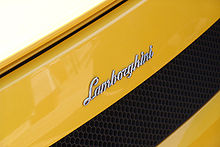
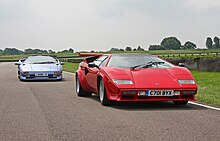
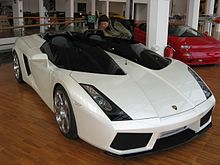





0 komentar:
Posting Komentar